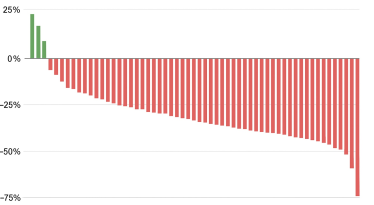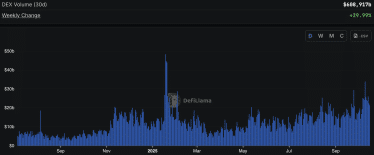“The cryptosphere experienced its biggest single-moment collapse since the FTX crash, losing more than $19 billion in a matter of hours. The reason was a technical problem on the largest crypto platform Binance, which led to a chain reaction of liquidations throughout the network. Will this sudden collapse be the beginning of the end of the era of centralized crypto-markets? Explained by Ruslan Linnyk, managing partner of Majinx Capital crypto fund Buy an annual subscription […]”, — write: businessua.com.ua

The cryptosphere experienced its biggest single-moment collapse since the FTX crash, losing more than $19 billion in a matter of hours. The reason was a technical problem at the largest crypto platform Binance, which led to a chain reaction of liquidations throughout the network. Will this sudden collapse be the beginning of the end of the era of centralized crypto-markets? Ruslan Linnyk, managing partner of the crypto fund Majinx Capital, explains
Purchase an annual subscription for six Forbes Ukraine magazines by value four issues If you prefer the quality, depth and power of a real experience, this is it subscription just for you
On October 11, the cryptosphere lost more than $19 billion in a matter of hours, which is the biggest instantaneous collapse since the bankruptcy of the FTX crypto platform. Bitcoin and Ethereum collapsed by tens of percent, hundreds of thousands of traders were liquidated, and news feeds were filled with headlines: “Trump is to blame for everything”.
However, if we set aside the political aspect, the reason was not geopolitics at all. It all started with a vulnerability in the centralized platform, where the information drive only exacerbated the system error.

popular Category Money Date Yesterday 100 days of Svyridenko’s government. Forbes Ukraine collected 13 difficult questions from business for the Prime Minister. That she answered them
“Collapse of security” Several circumstances coincided for Binance, the world’s largest crypto platform, on this day. The platform made it possible to borrow against USDe, wBETH and BNSOL tokens, but valued them not according to market data, but according to its internal prices.
On October 6, Binance announced that it was moving to a new market data system, but the launch was only scheduled for October 14. The eight days between these dates provided an opportunity for an attack.
During this time, a group of traders drained about $60-90 million USDe, which caused the exchange rate stablecoin on Binance, it fell to $0.65, although it remained close to the dollar on other platforms. The system recognized this as a “collateral collapse” and automatically liquidated users’ positions worth up to $1 billion.
Thus, a chain collapse was launched, which spread across all markets. All this happened because of one technical error in the architecture of Binance, which was successfully exploited at the most vulnerable moment.

On October 11, out of 429 assets on Binance, only three had a higher price than before the market crash. Source: Majinx Capital
Attack and profit While Binance struggled to cope with the chaos, on Hyperliquid new accounts opened short positions for $1.1 billion per BTC and ETHfinanced through the network Arbitrum. When prices began to fall, these positions produced about $192 million in net profit.
In fact, it was not a hack. It was an exploitation of a flaw in the provisioning assessment system under the influence of macroeconomic news. And perhaps the first time when the market was attacked not by code, but by the logic of a centralized platform.
Binance triggered a situation where an internal error became a common trigger. The platform essentially allowed its prices to be used as the “absolute truth” and any deviation instantly resulted in real losses for users.
After the collapse, Binance acknowledged “technical difficulties,” promised compensation, and promptly implemented external market data and minimum price thresholds. However, trust is a resource that is difficult to regain.
Binance has remained a liquidity hub for the entire market for years. But any monopoly sooner or later encounters its dark side – the loss of self-control.
The reaction of the world The market reacted instantly and voted with its wallet. More than $21 billion was withdrawn from Binance within a few days, and trading volumes on decentralized platforms increased by more than 30-40%.

Since October 11, more than $21 billion has been withdrawn from Binance in a few days, and trading volumes on decentralized exchanges have increased by more than 30-40% Photo by defillama.com
DEX protocols – Hyperliquid, Avantis, Uniswap, PancakeSwap – received an influx of new users. Traders remember the old truth: “Not your keys – not your funds”.
Binance’s sudden collapse was the first time a centralized player’s vulnerability triggered an avalanche of system-wide liquidations, forcing organizations to rethink their risk and trust architectures.
Reaction of Ukraine In Ukraine, this sudden collapse was received sensitively, with a transition to safer instruments: the market became more mature. Local traders and funds have long learned to spread risk, and part of the professional community left Binance as early as 2024.
For many participants, this is painful but necessary shock therapy. The market moves to less r sophisticated instruments, more cautious strategies and informed liquidity management.
Over time, interest in risky transactions will return, because the nature of the market is the same as human nature: the desire to get rich quickly will not go anywhere. As for professional participants, everything will remain unchanged: those who used margin trading or futures will continue to do so. For them, it is not just a hobby, but a profession.
The issue of education comes to the fore. Those who create products or educate new investors and traders need to think about what exactly they are conveying and what strategies they are forming. Because if the market teaches you to just push buttons without understanding the risk, it creates the conditions for the next crash.
Industry mapping Binance’s sudden crash isn’t just a system crash. This is a reflection of the entire industry. $90 million of local manipulation led to $19 billion in liquidations and showed how unstable the centralized model in the cryptosphere is.
This is not a story about the fall of a platform, but about a change in consciousness. The market has realized that centralization is its greatest vulnerability.
Binance will remain in the market. But the era of undisputed monopoly is coming to an end. A new era is coming in its place: decentralization, independent control and personal responsibility for one’s own keys.
Centralized giants build empires. But the crypt was never about empires. It is about independence.
The source
Please wait…
